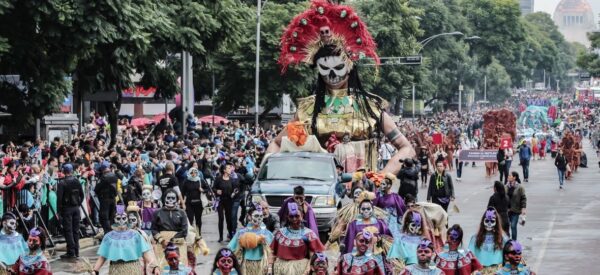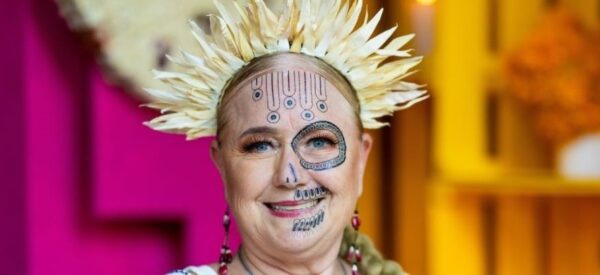DAY OF THE DEAD: Where to go, and stay, for Mexico’s most famous festival

Colourful el Día de los Muertos festivities have kicked off in Mexico, leading up to the actual Day of the Dead on Nov. 2, where Mexicans and visitors alike honour departed loved ones and reaffirm the bond between the worlds of the living and dead. Rather than somber, the occasion is joyous and raucous, yet also reflective.
The ancestral tradition dates back to pre-Hispanic Mexico, with roots originating in the cultures of Mesoamerica. Over time, these traditions were blended with Catholic beliefs to give rise to the holiday we know today, celebrated across Mexico.
The central pillar of the celebration is remembering the lives of those no longer living. Loved ones and family members take to cemeteries and each other’s homes with offerings of flowers, water, photographs of the deceased, their favorite food and drink, and other items that help to remember those who passed.
The celebration is so integral to Mexican culture that UNESCO has established it as a Cultural and Intangible Heritage of Humanity.
While celebrations take place in virtually every across the country, here are three places to experience Mexico’s most famous festival, and some local hotels that make the most of the celebrations:
Mexico City

Nowhere in Mexico celebrates Day of the Dead as vibrantly and passionately as Mexico City. The month-long celebration kicked off on Oct. 6 with the Festival de la Llorona en el Embarcadero de Cuemanco, which took place on the canals of Xochimilco, the Venice of the Americas in Mexico City.
On Oct. 18, the Festival de las Flores de Cempasúchil takes over Paseo de la Reforma with thousands of brilliantly coloured marigolds illuminating the path of the dead. It is estimated that five million marigold flowers will be produced this season.
Oct. 21 marks one of the most highly anticipated events of Day of the Dead in Mexico City: the Desfile de Alebrijes Monumentales, a parade of giant puppets that measure up to eight feet tall. Alebrijes are gorgeous works of art that blur the lines between reality and surrealism. They have become one of the most time-honoured traditions of Mexico City’s Day of the Dead.
The parade is a precursor to Mega Procesion de Catrinas, the following day, Oct. 22. The spectacle is a massive parade that begins at the Angel of Independence in Reforma and ends at the Zocalo, in the heart of the Centro Historico. Hundreds of gorgeous Catrinas take to the streets, with hauntingly beautiful painted faces, elaborate costumes, flowers, and music. La Catrina is the primary figure of Day of the Dead, a representation of an Aztec figure, The Goddess of Death, who was later popularized by engraver Jose Guadalupe Posada.
All of this is, of course, a build-up to the actual Day of the Dead. Celebrated between Oct. 31 and Nov. 5, this is when the offerings are made to the dearly departed. In Mexico City, the Zocalo hosts an Ofrenda Monumental, or massive offering that fills the entire plaza with altars, flowers, incense, photographs, and much more. Thousands of people take to the streets dressed as zombies for another festive, colorful, decked-out parade.
Hotel: Andaz Mexico City Condesa offers travellers a stylish stay conveniently located only 3 km from the starting point for Mexico City’s Day of the Dead Parade. The hotel will have special programming for the celebration that includes a spectacular Dia de los Muertos-themed art installation pop-up by local gallery Caminarte in the lobby (through Nov. 30), authentic Catrina facepainting for hotel guests (Oct. 28 and Nov. 2) and specialty food and beverage items throughout the hotel’s restaurants and eateries, including a special limited-edition pan de muerto and traditional Mexican hot chocolate available at Derba Matcha Café.
San Miguel de Allende
From Mexico City, visitors can venture to beautiful San Miguel de Allende (SMA), a UNESCO world heritage site pueblo recently rated the runner-up best city in the entire country by Condé Nast Traveler readers. For more local Día de los Muertos flavour, SMA offers visitors the chance to immerse themselves in local art and traditions.
Hotel: Located in the heart of the city, Casa de Sierra Nevada, A Belmond Hotel, is paying homage to tradition with an exclusive Día de los Muertos celebration in collaboration with renowned Mexican visual artist Betsabeé Romero. The hotel was recently named the 2nd best hotel in all of Mexico in the Condé Nast poll. The exclusive Day of the Dead experience contributes to San Miguel de Allende’s allure as a quintessential destination for traditional Dia de Muertos celebrations. Guests will have the opportunity to engage in conversations and experiences led by Romero herself while perusing vibrant recycled plastic flowers, hand-printed latex skulls, and more. As a multi-disciplinary artist, Romero is known for her impactful work that combines various mediums and explores themes of cultural heritage, identity, and social change.
Guests booking a minimum three-night stay between Oct. 31 and Nov. 5 will receive welcome cocktails, daily breakfast, a La Catrina (skeleton) makeup session for two, and a Romero-designed personal altar kit that enables guests to build their own altars dedicated to loved ones directly in their ample guest rooms. The celebration culminates with an exclusive cocktail event on the rooftop bar on Nov. 1 and a dinner party at Andanza Restaurant on Nov. 2. Featuring an educational conversation with Betsabeé Romero, the immersive experience offers a deep understanding of the cultural significance of Día de Muertos while offering traditional culinary dishes including Pozole, Tamales, Dulce de Calabaza (pumpkin candy), and Pan de Muerto.
Riviera Maya

Family travellers may be best suited to visit the Riviera Maya, where all-inclusive resorts bring the Day of the Dead to hotel guests, from Mexican gastronomy to dancing to workshops and even a concert by renowned Mexican artist Natalia Lafourcade on property.
Every year from Oct. 30 to Nov. 3, Xcaret into a vibrant tapestry of Mexican culture and tradition during the annual Festival of Life and Death Traditions. The tradition, now in its 17th edition, offers visitors a heartfelt tribute to one of Mexico’s most treasured customs, recognized as an Intangible Cultural Heritage of Humanity by UNESCO. Guests can expect a rich variety of experiences, including captivating theatre performances, Mexican gastronomy, musical presentations, hands-on workshops, dance shows, exhibitions, a dedicated children’s area and two shows by renowned Mexican singer and three-time Grammy Award Winner Natalia Lafourcade taking place Nov. 1 and 2.
The festival will feature three monumental altars, 330 artistic presentations, 15 simultaneous forums, theatrical tours, among other activities, where over 960 artists will engage visitors over a total of five days. In addition, the cultural event is a celebration for adults and children alike and at the new Interactive Hacienda children’s area, where families can learn about the traditions surrounding the Day of the Dead through theatre presentations, puppet shows, an art exhibition, photography, sculpture, and workshops teaching traditional Mexican arts and crafts.
The cultural fusion will include tastings and traditional dishes of Querétaro, the invited region. There will also be parades led by Grupo Aztlan and the student band from the Autonomous University of Querétaro (UAQ), as well as musical performances by Grupo Xaha, Grupo Bohemio, Trio Queretanas, and Trio Gallardia Huasteca.
Hotels: The main venue for the festival will be Xcaret Park and will also include Hotel Xcaret Mexico, Hotel Xcaret Arte and La Casa de la Playa.
First published at Travel Industry Today





